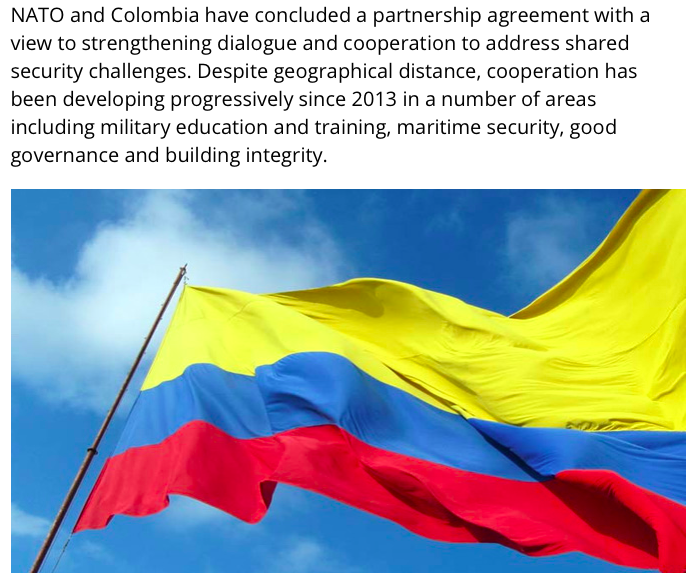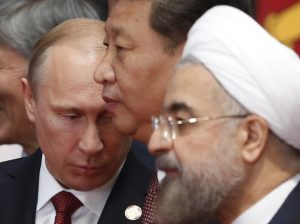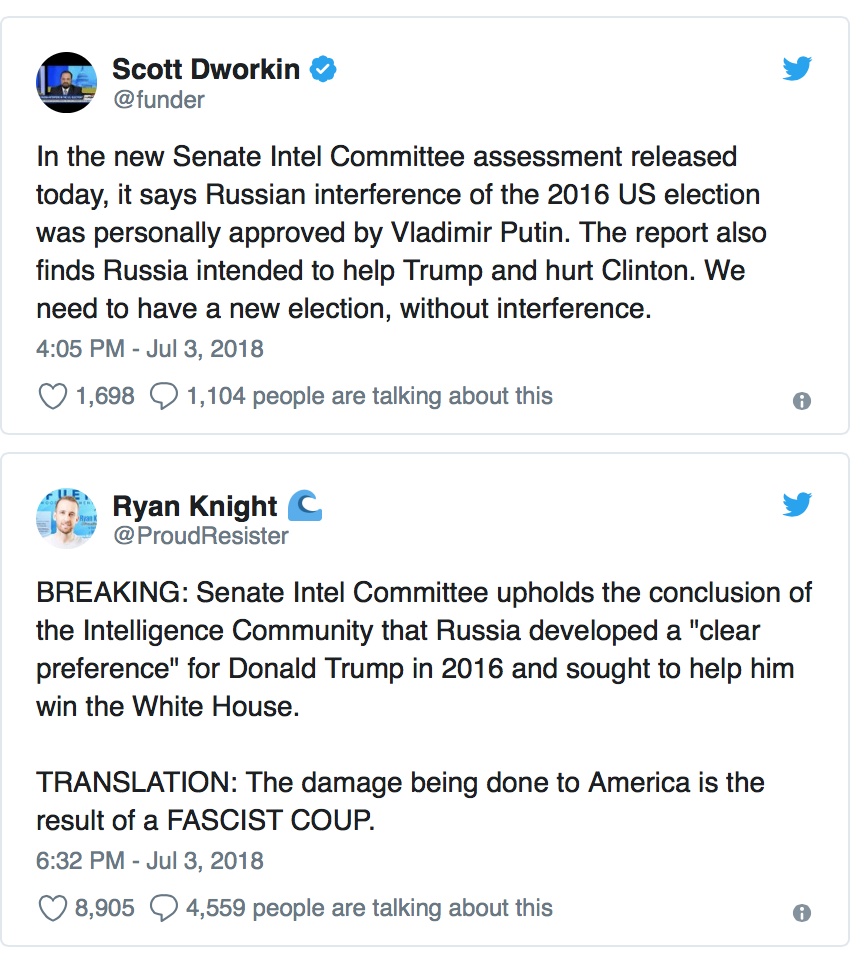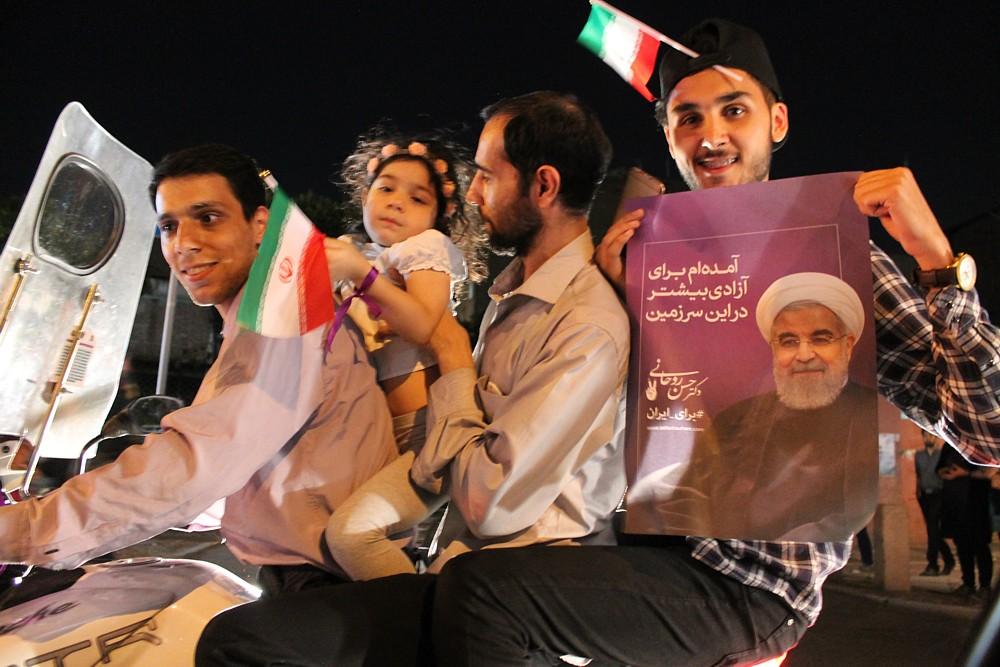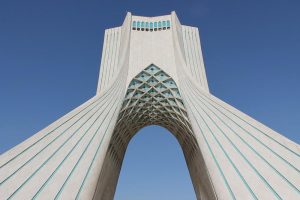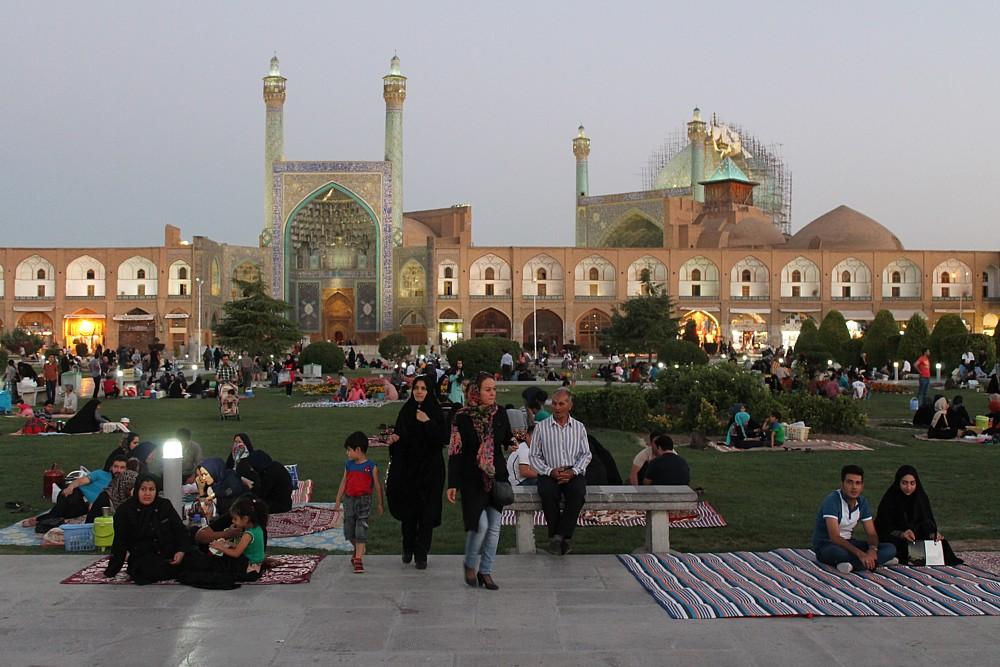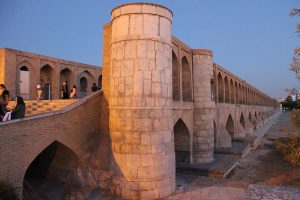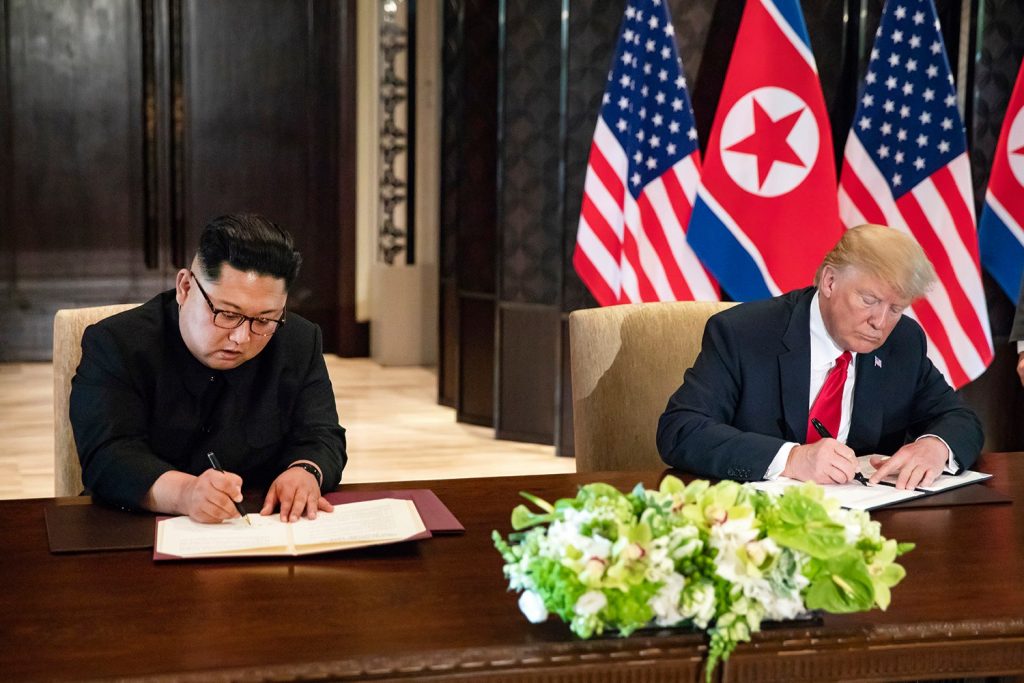Author’s Introductory Note
Environmental modification techniques (ENMOD) for military use constitute, in the present context of global warfare, the ultimate weapon of mass destruction.
Rarely acknowledged in the debate on global climate change, the world’s weather can now be modified as part of a new generation of sophisticated electromagnetic weapons. Both the US and Russia have developed capabilities to manipulate the climate for military use.
Environmental modification techniques have been applied by the US military for more than half a century. US mathematician John von Neumann, in liaison with the US Department of Defense, started his research on weather modification in the late 1940s at the height of the Cold War and foresaw ‘forms of climatic warfare as yet unimagined’. During the Vietnam war, cloud-seeding techniques were used, starting in 1967 under Project Popeye, the objective of which was to prolong the monsoon season and block enemy supply routes along the Ho Chi Minh Trail.
The US military has developed advanced capabilities that enable it selectively to alter weather patterns. The technology, which was initially developed in the 1990s under the High-frequency Active Auroral Research Program (HAARP), was an appendage of the Strategic Defense Initiative – ‘Star Wars’. From a military standpoint, HAARP –which was officially abolished in 2014– is a weapon of mass destruction, operating from the outer atmosphere and capable of destabilising agricultural and ecological systems around the world.
Officially, the HAARP program has been closed down at its location in Alaska. The technology of weather modification shrouded in secrecy, nonetheless prevails.
Weather-modification, according to the US Air Force document AF 2025 Final Report, “offers the war fighter a wide range of possible options to defeat or coerce an adversary”, capabilities, it says, extend to the triggering of floods, hurricanes, droughts and earthquakes:
‘Weather modification will become a part of domestic and international security and could be done unilaterally… It could have offensive and defensive applications and even be used for deterrence purposes. The ability to generate precipitation, fog and storms on earth or to modify space weather… and the production of artificial weather all are a part of an integrated set of [military] technologies.”
In 1977, an international Convention was ratified by the UN General Assembly which banned ‘military or other hostile use of environmental modification techniques having widespread, long-lasting or severe effects.’ According to the Convention on the Prohibition of Military or Any Other Hostile Use of Environmental Modification Techniques:
The term “environmental modification techniques” refers to any technique for changing – through the deliberate manipulation of natural processes – the dynamics, composition or structure of the Earth, including its biota, lithosphere, hydrosphere and atmosphere, or of outer space. (Convention on the Prohibition of Military or Any Other Hostile Use of Environmental Modification Techniques, United Nations, Geneva: 18 May 1977)
While the substance of the 1977 Convention was reasserted in the UN Framework Convention on Climate Change (UNFCCC) signed at the 1992 Earth Summit in Rio, debate on weather modification for military use has become a scientific taboo.
Military analysts and scientists are mute on the subject. Meteorologists are not investigating the matter and environmentalists are largely focussing on greenhouse gas emissions under the Kyoto Protocol. The possibility of climatic or environmental manipulations as part of a military and intelligence agenda, while tacitly acknowledged, is not part of the broader debate on climate change under UN auspices.
While discussion of the post Cold War military applications of weather warfare is a taboo, the US Air Force has nonetheless acknowledged the strategic importance of ENMOD techniques in the modern battlefield of non-conventional warfare and intel ops, including the conduct, without the enemy’s knowledge, of “covert” weather modification operations.
While the US Air Force acknowledges that ENMOD weapons are part of their military arsenal, there is no formal proof or evidence that ENMOD techniques have been used by the US military against a foreign country or enemy of the US.
At this juncture in our history, US-NATO forces are deployed worldwide.
The US and its allies are waging war on Syria and Iraq and targeting Iran and North Korea. They are also threatening Russia and China.
The Pentagon has formulated the contours of a global military agenda, a “long war”, a war without borders.
“Weather warfare” is the ultimate WMD with the potential of destabilizing an enemy’s ecosystem, destroying its agriculture, disabling communications networks. In other words, ENMOD techniques can undermine an entire national economy, impoverish millions of people and “kill a nation” without the deployment of troops and military hardware.
The following text, with the exception of some small edits was first published in September 2004.
The 2004 article was a follow-up on an earlier study by the author entitled Washington’s New World Order Weapons Have the Ability to Trigger Climate Change, published by Global Research and Third World Resurgence, January 2001.
While The Ecologist published in 2007 a shorter version of this article, the issue of climatic manipulation for military use has largely been ignored by Environmentalists.
This essay is dedicated to the memory of Sister Dr. Rosalie Bertell, who, from the very outset revealed the diabolical nature of the HAARP project, as part of an integrated non-conventional weapons program:
“It is related to fifty years of intensive and increasingly destructive programs to understand and control the upper atmosphere. … HAARP is an integral part of a long history of space research and development of a deliberate military nature. The military implications of combining these projects is alarming. …
The ability of the HAARP / Spacelab/ rocket combination to deliver very large amounts of energy, comparable to a nuclear bomb, anywhere on earth via laser and particle beams, are frightening. The project is likely to be “sold” to the public as a space shield against incoming weapons, or, for the more gullible, a device for repairing the ozone layer.” (Dr. Rosalie Bertell)
It is my sincere hope that this article will renew the debate on the dangers of weather warfare and will contribute to the broader objective of World peace which requires the relentless “disarming” of the US- NATO military apparatus.
Officially, the HAARP program has been closed down at its location in Alaska. The technology of weather modification shrouded in secrecy, nonetheless prevails.
CBC 1996 News documentary: HAARP – US military weather weapon
Michel Chossudovsky, May 18 2015
The Ultimate Weapon of Mass Destruction:
“Owning the Weather” for Military Use
by Michel Chossudovsky
Minor edits: September 2023. The URL of the original article 2001 article is: http://globalresearch.ca/articles/CHO409F.html
Weather Warfare
The significant expansion in America’s weather warfare arsenal, which is a priority of the Department of Defense is not a matter for debate or discussion. While, environmentalists blame the Bush administration for not having signed the Kyoto protocol, the issue of “weather warfare”, namely the manipulation of weather patterns for military use is never mentioned.
The US Air Force has the capability of manipulating climate either for testing purposes or for outright military-intelligence use. These capabilities extend to the triggering of floods, hurricanes, droughts and earthquakes. In recent years, large amounts of money have been allocated by the US Department of Defense to further developing and perfecting these capabilities. The U.S Air Force in its 1996 report explicitly refers to “Owning the Weather in 2025”
Weather modification will become a part of domestic and international security and could be done unilaterally… It could have offensive and defensive applications and even be used for deterrence purposes. The ability to generate precipitation, fog, and storms on earth or to modify space weather, … and the production of artificial weather all are a part of an integrated set of technologies which can provide substantial increase in US, or degraded capability in an adversary, to achieve global awareness, reach, and power.
(see Weather as a Force Multiplier, Owning the Weather in 2025, See also US Air Force, Air University of the US Air Force, AF 2025 Final Report)
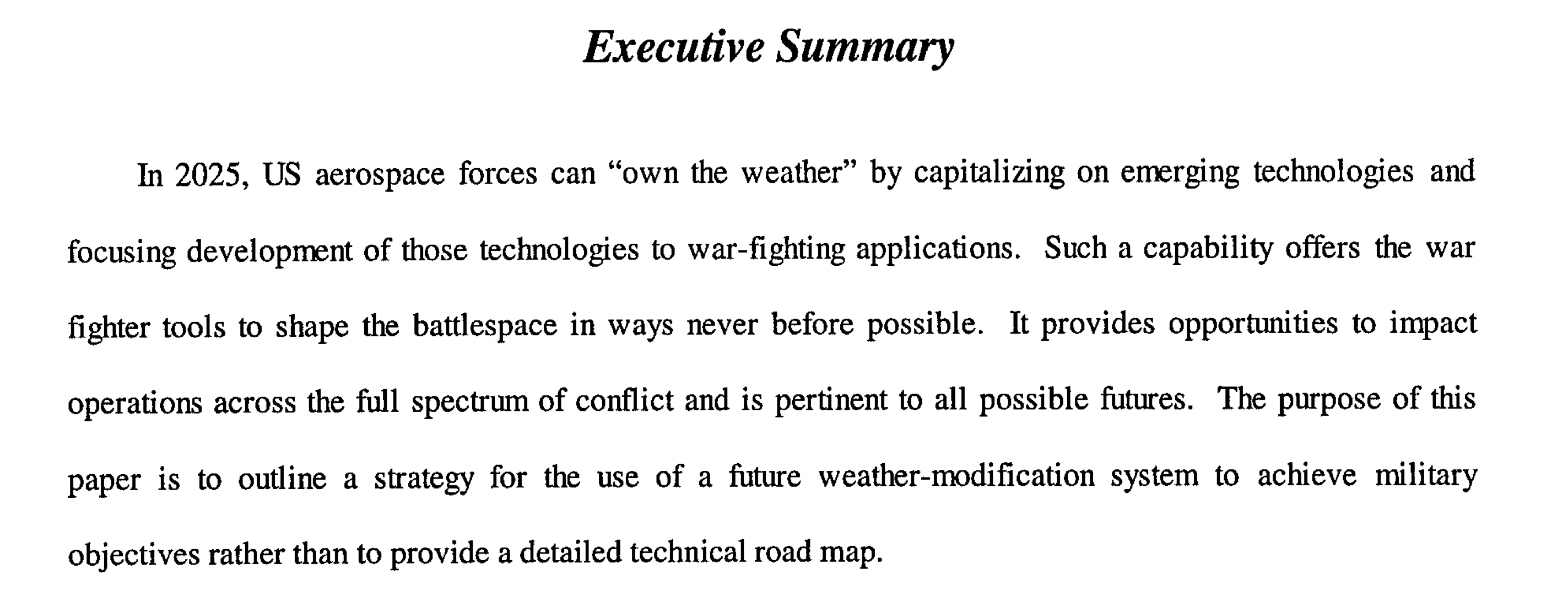
While there is no firm evidence that the US Air Force weather warfare facilities have been applied to modify weather patterns, one would expect that if these capabilities are being developed for military use, they would at least be the object of routine testing, much in the same way as the testing of new conventional and strategic weapons systems.
Needless to say, the subject matter is a scientific taboo. The possibility of climatic or environmental manipulations as part of a military and intelligence agenda, while tacitly acknowledged, is never considered as relevant. Military analysts are mute on the subject. Meteorologists are not investigating the matter, and environmentalists are strung on global warming and the Kyoto protocol.
Ironically, the Pentagon, while recognizing its ability to modify the World’s climate for military use, has joined the global warming consensus. In a major study published by climate.org (pdf) [link no longer available], the Pentagon has analyzed in detail the implications of various global warming scenarios. The Pentagon document constitutes a convenient cover-up. Not a word is mentioned about its main weather warfare program: The High-Frequency Active Auroral Research Program (HAARP) based in Gokona, Alaska –jointly managed by the US Air Force and the US Navy.
There are several mainstream explanations on weather and climate change, none of which fully explains, within their respective terms of reference, the highly unusual and erratic weather occurrences, not to mention the human toll and devastation, which have led to the destabilization of entire agricultural and eco-systems. Needless to say these explanations never address the issue of climate manipulation for military use.
Climatic Manipulation by the US Military: The HAARP Program
The High-Frequency Active Auroral Research Program (HAARP) based in Gokona, Alaska, has been in existence since 1992. It is part of a new generation of sophisticated weaponry under the US Strategic Defense Initiative (SDI). Operated by the Air Force Research Laboratory’s Space Vehicles Directorate, HAARP constitutes a system of powerful antennas capable of creating “controlled local modifications of the ionosphere” [upper layer of the atmosphere]:
“[HAARP will be used] to induce a small, localized change in ionospheric temperature so that resulting physical reactions can be studied by other instruments located either at or close to the HAARP site”. (HAARP website)
Nicholas Begich –actively involved in the public campaign against HAARP– describes HAARP as:
“A super-powerful radiowave-beaming technology that lifts areas of the ionosphere by focusing a beam and heating those areas. Electromagnetic waves then bounce back onto earth and penetrate everything — living and dead.”
(for further details see Michel Chossudovsky, http://www.globalresearch.ca/articles/CHO201A.html )
World renowned scientist Dr. Rosalie Bertell depicts HAARP as
“a gigantic heater that can cause major disruptions in the ionosphere, creating not just holes, but long incisions in the protective layer that keeps deadly radiation from bombarding the planet.” (quoted in Chossudovsky, op cit.)
According to Richard Williams, a physicist and consultant to the David Sarnoff laboratory in Princeton HAARP constitutes “an irresponsible act of global vandalism.”
He and others fear a secret second stage where HAARP would
“beam much more energy into the ionosphere. That could produce a severe disruption of the upper atmosphere at one location that may produce effects that spread rapidly around the Earth for years.” (Quoted in Scott Gilbert, Environmental Warfare and US Foreign Policy: The Ultimate Weapon of Mass Destruction,
HAARP has been presented to public opinion as a program of scientific and academic research. US military documents seem to suggest, however, that HAARP’s main objective is to “exploit the ionosphere for Department of Defense purposes.” (quoted in Chossudovsky, op cit).
Without explicitly referring to the HAARP program, a US Air Force study points to the use of “induced ionospheric modifications” as a means of altering weather patterns as well as disrupting enemy communications and radar. (Ibid)
HAARP also has the ability of triggering blackouts and disrupting the electricity power system of entire regions.
An analysis of statements emanating from the US Air Force points to the unthinkable: the covert manipulation of weather patterns, communications systems and electric power as a weapon of global warfare, enabling the US to disrupt and dominate entire regions of the World.
Weather Warfare: A Corporate Bonanza
HAARP has been operational since the early 1990s. Its system of antennas at Gakona, Alaska, was initially based on a technology patented by Advanced Power Technologies Inc. (APTI), a subsidiary of Atlantic Ritchfield Corporation (ARCO).
The first phase of the HAARP Ionospheric Research Instrument (IRI) was completed by APTI. The IRI system of antennas was first installed in 1992 by a subsidiary of British Aerospace Systems (BAES) using the APTI patent. The antennas beam into the outer-atmosphere using a set of wireless high frequency transmitters.
In 1994, ARCO sold its APTI subsidiary, including the patents and the second phase construction contract to E-Systems, a secretive high tech military outfit allegedly with links to US intelligence
E-Systems specializes in the production of electronic warfare equipment, navigation and reconnaissance machinery, including “highly sophisticated spying devices”:
“[E-Systems] is one of the biggest intelligence contractors in the world, doing work for the CIA, defense intelligence organizations, and others. US$1.8 billion of their annual sales are to these organizations, with $800 million for black projects-projects so secret that even the United States Congress isn’t told how the money is being spent. (See Earthpulse.com on HAARP Program
“The company has outfitted such military projects as the Doomsday Plan (the system that allows the President to manage a nuclear war) and Operation Desert Storm.” (See Princeton Review, link no longer available),
With the purchase of APTI, E-Systems acquired the strategic weather warfare technology and patent rights, including Bernard J. Eastlund‘s US Patent No: 4,686,605 entitled “Method and Apparatus for Altering a Region in the Earth’s Atmosphere, Ionosphere and/or Magnetosphere”.
It is worth mentioning that the Eastlund /APTI patents were based on the research of Yugoslav scientist Nicola Tesla (many of whose ideas were stolen by US corporations). (See Scott Gilbert, Environmental Warfare and US Foreign Policy: The Ultimate Weapon of Mass Destruction)
Eastlund described this deadly technology as capable of:
“causing…total disruption of communications over a very large portion of the Earth…missile or aircraft destruction, deflection or confusion… weather modification…” (Wealth4Freedom.com)
Not surprisingly, the patent had previously been sealed under a government secrecy order.
Barely a year following the E-Systems purchase of APTI’s weather warfare technology, E-Systems was bought out by Raytheon, the fourth largest US military contractor.
Through this money-spinning acquisition, Raytheon became the largest “defense electronics” firm in the World.
Meanwhile, ARCO which had sold APTI to E-Systems, had itself been acquired by the BP-AMOCO oil consortium, thereby integrating the largest oil company in the World (BP).
Raytheon through its E-Systems subsidiary now owns the patents used to develop the HAARP weather warfare facility at Gakona Alaska. Raytheon is also involved in other areas of weather research for military use, including the activities of its subsidiary in Antarctica, Raytheon Polar Services.
“Owning the Weather”: Towards the Expanded Final Stage
The HAARP antenna array and transmitters were slated to be built in several distinct phases
http://www.haarp.alaska.edu/haarp/phases.html
During the Clinton administration, the “Filled Developmental Prototype” (FDP), namely a system composed of an array of 48 active antenna elements with connected wireless transmitters, was installed and completed at the HAARP facility in 1994.
(See Figure 1 below)
Under the initial Developmental Prototype (DP), only 18 of the 48 transmitters were connected.
Bernard Eastlund in a 1997 interview described this antenna array in its Filled DP stage as the
“the largest ionospheric heater ever built”.
This system of 48 antennas, however, while fully operational, was not according to Eastlund, powerful enough (in 1997)
“to bring the ideas in his patents to fruition”:.
“But they’re getting up there”, he said. “This is a very powerful device. Especially if they go to the expanded stage.”
(quoted in Scott Gilbert, op cit)
This ‘final expanded stage’ envisioned by Eastlund, which will provide maximum capability to manipulate the World’s weather patterns, has now been reached.
Under the Bush administration, the main partner of Raytheon (which owns the patents) in the construction and development stage of the HAARP antenna array, is British Aerospace Systems (BAES), which had been involved in the initial installation of the antenna array in the early 1990s.
The multimillion dollar contract was granted by The Office of Naval Research to BAES in 2003, through its US subsidiary BAE Systems Advanced Technologies Inc. The contract was signed barely two months before the Anglo-American invasion of Iraq.
Using Raytheon’s technology, BAES was to develop the HAARP Ionospheric Research Instrument (IRI) to its maximum capabilities of “Full size or final IRI (FIRI)”.
In April 2003, BAE Systems Advanced Technologies outsourced the production and installation of the antennas to Phazar Corp, a company specializing in advanced wireless antennas for military use.
Phazar owns Antenna Products Corporation of Mineral Wells, Texas. Phazar was entrusted with producing and installing 132 crossed dipole antennas items for the HAARP facility. See
(http://www.antennaproducts.com/News Release 2004-18-03.pdf )
A year later, in April 2004, the final phase in the expansion of the HAARP facility was launched. (Dept of Defense, 19 April 2004).
This phase consisted in equipping all the 180 antennas with high frequency transmitters. BAE Systems was awarded another lucrative contract, this time for $35 million.
In July 2004, Phazar had delivered and installed the 132 crossed dipole antennas including the antenna support structures and ground screen items at the HAARP facility, bringing the number of antennas from 48 under the FDP stage to 180. (see Table 2).
Meanwhile, BAE Systems had contracted with Jersey based defense electronics firm DRS Technologies, Inc in an $11.5 million outsourcing arrangement, the production and installation of the high-frequency (HF) radio transmitters for the HAARP antenna array. DRS specializes in a variety of leading edge products for the U.S. military and intelligence agencies.
Under its contract with BAE Systems Information and Electronic Warfare Systems in Washington, D.C., DRS is to manufacture and install “more than 60 Model D616G 10-Kilowatt Dual Transmitters” to be used with the HAARP system of antennas.
(It is unclear from the company statements whether all the 180 antennas will be equipped with a transmitter, bringing the system up to full IRI capabilities).
Deliveries and installation are to be completed by July 2006. While HAARP is described as a “research project”, the production of the transmitters was entrusted to DRS’ C41 “Command, Control, Communications, Computers and Intelligence (C4I) Group”
The diagram and images below describe the HAARP Alaska Facility in 1997. [Note most of the url links are broken as a result of the closure of the HAARP facility]
Figure 1:
The Array of 48 Antenna Elements with the Transmitter Shelters (FDP stage). 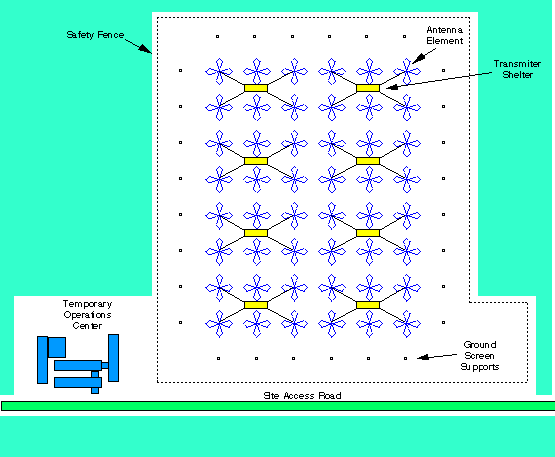
The newly installed 132 dipole antennas supplied by Phazar vastly increase the size of the HAARP Alaska facility; the new transmitters are supplied and installed by DRS

Image 1: Aerial Photo of the HAARP Alaska Site
Source: http://www.haarp.alaska.edu/haarp/ohd.html
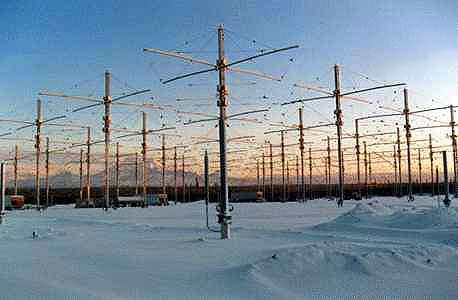
Image 2: HAARP Antenna Array
Source: http://www.haarp.alaska.edu/haarp/HaarpSite.html
The 48 antenna array is supported by transmitter shelters, each of which contains 6 transmitter cabinets. (See image of shelter below)
Each cabinet contains two transmitters. (image of cabinet below)
Image 3 Transmitter Shelter. [no longer available ]
http://www.haarp.alaska.edu/haarp/images/trans/transtr.jpg
Transmitter Shelter containing Six Transmitter Cabinets. Each Cabinet contains two transmitters

Image 4: Inside the Transmitter Shelter
http://www.haarp.alaska.edu/haarp/images/trans/shelter.jpg

Image 5. Two Transmitters making up a Transmitter Cabinet [no longer available]
http://www.haarp.alaska.edu/haarp/images
Testing of HAARP Equipment (2003- 2004)
It is worth noting that the expansion of the antenna array (e.g. during 2003-2004) required, as part of the contracts reached with BAE Systems and its various subcontractors, the routine testing of the installed weather warfare equipment. An intermediate stage Limited IRI (LIRI), could be in operation by 2004, following the completion of the 180 antenna array under the Phazar contract and pending the final delivery of the remaining HF radio transmitters.
In this regard, a report published by the Russian parliament (Duma) in 2002, suggests that the US Military had plans to test its weather modification techniques at its Alaska facility, as well as at two other sites:
“The committees reported that the USA is planning to test three facilities of this kind. One of them is located on the military testing ground in Alaska and its full-scale tests are to begin in early 2003. The second one is in Greenland and the third one in Norway.
“When these facilities are launched into space from Norway, Alaska and Greenland, a closed contour will be created with a truly fantastic integral potential for influencing the near-Earth medium,” the State Duma said.
The USA plans to carry out large-scale scientific experiments under the HAARP program, and not controlled by the global community, will create weapons capable of breaking radio communication lines and equipment installed on spaceships and rockets, provoke serious accidents in electricity networks and in oil and gas pipelines and have a negative impact on the mental health of people populating entire regions, the deputies said. (Interfax News Agency, original Russian, BBC Monitoring, 8 August 2002, emphasis added)
Whether this report by the Russian Duma on testing “starting in early 2003” is correct or not, the US administration must be confronted nationally and internationally, at the political and diplomatic levels, at the UN and the US Congress, by the international scientific community, by environmentalists and the antiwar movement. The future of humanity is threatened by the use of weather modification techniques.
Moreover, to wage an effective campaign, it is essential that corroborating scientific investigation of the unusual weather occurrences observed in recent years (and particularly since early 2003) be undertaken. This investigation should be far-reaching, collecting relevant data, correlating specific weather occurrences to recorded antenna activity at the Alaska site as well as at the two other sites, etc.
The Full Size Ionospheric Research Instrument FIRI stage, described as “a maximum size of 180 antenna elements, arranged in 15 columns by 12 rows” is scheduled to be completed by mid-2006 (assuming the installation of the remaining dual transmitters), at which time the HAARP program will have reached its maximum FIRI capacity, meaning the ability to selectively modify, for military use, weather patterns anywhere in the World.
“The IRI is currently [June 2004] composed of 48 antenna elements and has a power capacity of 960,000 watts. When installed, the additional 132 transmitters will give HAARP a 3.6 mega-watt capacity [see Table 2 below]. The HAARP build-out is jointly funded by the U.S. Air Force, the U.S. Navy and the Defense Advanced Research Projects Agency (DARPA). (Business Wire, 10 June 2004)
Table 2: Comparison of IRI Phases
|
DP
|
FDP
|
LIRI
|
FIRI
|
|
Number of Active Antenna Elements
|
18
|
48
|
108
|
180
|
|
Total Transmitter Power (kW)
|
360
|
960
|
2160
|
3600
|
|
Maximum Antenna Gain (dB)
|
19
|
24
|
29
|
31
|
|
Max Effective Radiated Pwr (dBW)
|
74
|
84
|
92
|
96
|
|
Min Antenna Pattern Width (degrees)
|
9
|
8
|
5
|
|
Frequency Range
|
2.8 to 10 MHz
|
|
Modulation Types
|
CW/AM/FM/PM
|
Source http://www.haarp.alaska.edu/haarp/phases.html
This advanced stage of full capacity (FIRI) corresponds to what the US Air Force has called “Owning the Weather”:
US aerospace forces [will] ‘own the weather’ by capitalizing on emerging technologies and focusing development of those technologies to war-fighting applications… From enhancing friendly operations or disrupting those of the enemy via small-scale tailoring of natural weather patterns to complete dominance of global communications and counterspace control, weather-modification offers the war fighter a wide-range of possible options to defeat or coerce an adversary… In the United States, weather-modification will likely become a part of national security policy with both domestic and international applications. Our government will pursue such a policy, depending on its interests, at various levels.
(US Air Force, emphasis added. Air University of the US Air Force, AF 2025 Final Report, http://www.au.af.mil/au/2025/ )
Weather Warfare against “Rogue States”
The unusual climatic occurrences in the US and Western Europe have been extensively documented.
However, what the news media has failed to underscore is that a number of unusual and dramatic climatic changes have occurred in recent years [prior to the publication of this article] in countries which are identified as possible targets under the US Administration’s pre-emptive war doctrine.
There is no evidence or proof that these unusual weather patterns are the consequence of weather warfare.
Weather patterns in North Korea, for instance, have been marked since the mid-1990s by a succession of droughts, followed by floods. The result has been the destruction of an entire agricultural system. (See details in Annex)
In Cuba, the pattern is very similar to that observed in North Korea. (See details in Annex)
In Iraq, Iran and Syria, a devastating drought occurred in 1999.
In Afghanistan, four years of drought in the years preceding the US led invasion in 2001, have led to the destruction of the peasant economy, leading to widespread famine.
While there is no proof that these weather occurrences are the result of climatic warfare, Phillips Geophysics Lab, which is a partner in the HAARP project provides a course for military personnel at the Hanscom Air Force Base in Maryland, on “Weather Modification Techniques”. The course outline explicitly contemplates the triggering of storms, hurricanes, etc. for military use.
(See his slide show at http://www.dtc.army.mil/tts/1997/proceed/abarnes/
Open PowerPoint presentation at http://www.dtc.army.mil/tts/tts97/abarnes.zip ) [links no longer accessible]
Weather manipulation is the pre-emptive weapon par excellence. It can be directed against enemy countries or even “friendly nations”, without their knowledge.
Weather warfare constitutes a covert form of pre-emptive war. The manipulation of climate can be used to destabilize an enemy’s economy, ecosystem and agriculture (e.g. North Korea or Cuba). Needless to say it can trigger havoc in financial and commodity markets and can potentially be used as an instrument of “insider trade” for financial gain. It has the ability of destabilizing a country’s institutions. Concurrently, the disruption in agriculture creates a greater dependency on food aid and imported grain staples from the US and other Western countries.
The Bush administration has stated that it reserves the right to attack these countries preemptively, with a view to ensuring the security of the American homeland.
Washington –as part of its nuclear posture review– has threatened several countries including China and Russia with pre-emptive nuclear strikes. One would assume that the same targeting of rogue states exists with regard to the use of weather modification techniques”.
While there is no evidence of the use of weather warfare against rogue states, the policy guidelines on “weather intervention techniques” have already been established and the technology is fully operational.
Annex
Country Case Studies:
Unusual Weather Occurrences
Note:
While the US Air Force acknowledges that ENMOD weapons are part of the military arsenal, there is no formal proof or evidence that ENMOD techniques have been used by the US military against a foreign country or enemy of the US.
There is no firm evidence that the unusual weather patterns recorded below are the result of climatic warfare. Recorded in this Appendix are weather patterns in selected countries in the 1990s and up until the time of writing in 2004. In some cases, the url links to the original sources are no longer available.
North Korea (1995-1999)
Recurrent flooding and drought often in the same year has hit North Korea since 1995, 220,000 people died in the ensuing famine, according to Pyongyang’s own figures. U.S. figures place the number of deaths resulting from famine at 2 million.
The first major flooding occurred in 1995.
There were floods and drought in 1999. The serious water shortage resulting from the 1999 drought was conducive to the destruction of crops.
“The temperature of water in rice fields goes beyond 40 degrees and the tall rice plants fresh from the rice seedling beds are withering. In particular, nearly all after-crop maize seedlings and seeds are perishing,” it added.
In 2001, in June there was an extensive drought with rainfall just 10% of normal levels, which served to undermine agricultural crops. And then a few months later, in October, there were extensive floodings leading to the further destruction of rice harvests and a crisis situation in food distribution.
“Officials in Kangwon province – an area which already suffers food shortages – say the impact of the torrential rain and flooding has been devastating. The normal recorded rainfall for October should be around 20mm. But in the worst-affected areas 400mm (18 inches) of rain fell in just 12 hours. “It was the worst flooding we’ve had since records began in 1910,” said Kim Song Hwan, head of the government’s Flood Damage Rehabilitation Committee for the region.
(BBC, 23 Oct 2001, http://news.bbc.co.uk/1/hi/world/asia-pacific/1614981.stm)
Cuba (1998-2004)
For several years Cuba has been affected by recurrent droughts. In 1998, rainfall in Eastern Cuba was at its lowest level since 1941.
A United Nations team estimated 539,000 people, 280,000 of them farmers, were directly affected by reduced availability of food or reduced income through production losses. Some reported effects are: hunger in areas; a loss of up to 14% of the sugar cane crop planted last year and a reduction in this spring’s planted crops, since rains were not sufficient for some seeds to germinate (which will reduce next year’s crop); as much as 42% losses in food staples such as root vegetables, beans, bananas, and rice in the five eastern provinces; and livestock, poultry, and egg production losses
(UN Relief, http://www.reliefweb.int/w/rwb.nsf/0/2975570e60ff2a7685256680005a8e2d?OpenDocument )
In 2003, a devastating drought hit the Western part of Cuba
In 2004 May-June, the country is hit by the worst drought in its history:
“A severe drought enveloping eastern Cuba has eroded 40 percent of the farmland, starved thousands of heads of cattle and has close to 4 million people counting every drop of water they consume.” The drought is described as the worst in 40 years.
“The drought has robbed underground water levels of some 10 feet over the past 10 years, leaving over 5,000 wells across the province dry,” said Leandro Bermudez, a geologist and the second man at Cuba’s National Institute of Hydraulic Resources.
(MSNBC, 21 June 2004 http://msnbc.msn.com/id/5262324
The cities are running out of water. According to the Independent, “Drought is bringing Cuba to its knees:
Unnoticed by the world, the longest dry period for decades has brought much of Cuba to its knees. Could this be the crisis that finally destroys Fidel’s revolution?” (Independent)
“All across central and eastern Cuba, farmers, ranchers, city dwellers and government officials are scrambling to deal with a punishing drought that began a decade ago and intensified in the last two years.
Although traditionally arid, the provinces of Holguin, Camaguey and Las Tunas hold some of Cuba’s finest pasture and farmland and have long been crucial to this communist nation’s dairy, beef and agricultural industries.
More than 12,500 cattle have died in Holguin alone in 2004 and milk production has fallen 20 percent. The price of beans, plantains, sweet potatoes and other staples has soared in private markets.
The drought has caused millions of dollars in losses and officials are spending millions more digging wells, building a water pipeline and taking other measures to try to ease the crisis – huge sums in an impoverished nation struggling through tough economic times and a battle with the United States.
Officials also have moved thousands of cattle to more fertile areas and are working furiously to finish a 32-mile pipeline that will draw water to Holguin city from Cuba’s largest river, the Cauto. The $5 million pipeline could be completed next month. (Chicago Tribune, July 29, 2004)
(Chicago Tribune, July 29, 2004, http://www.thestate.com/mld/thestate/news/world/9271316.htm )
The above report dates to July 2004, it was published before the hurricanes hit the Cuban coastline followed by torrential rains.
Afghanistan and The former Soviet Republics of Central Asia
The worst drought in Afghanistan’s history occurred in the three consecutive years prior to the onslaught of the US led invasion, from 1999 to 2001.
The agricultural recovery of the 1990s, in the wake of the Soviet-Afghan war was brought to a standstill.
In the wake of the US led 2001 invasion, the United States supplied Afghanistan with genetically modified wheat and appropriate types of fertilizer to be used with the GM wheat, which was said to be high yield drought resistant. The donation of GM wheat, however, also led to destabilizing the small peasant economy because the GM wheat varieties could not be reproduced locally. In 2002, famines which were barely reported by the media, swept the country.
Similar although less severe conditions prevailed in the former Soviet republics of Kazakhstan, Kyrgyzstan, Tajikistan, Turkmenistan, and Uzbekistan.
Like Afghanistan, Tajikistan has had its infrastructure ruined by prolonged civil war with Muslim fundamentalists. Since then, the worst regional drought in 74 years has destroyed food crops over a large part of the nation, rendering almost half of the 6.2 million people in the country vulnerable to the threat of famine and disease, up from 3 million last year. About the only portion of the economy that has been unaffected is the drug trade. Tajikistan is the transit route for 65 to 85 percent of heroin smuggled out of Afghanistan, the world’s largest producer.
(http://www.americanfreepress.net/Mideast/Drought__Desperation_Breed_Vio/drought__desperation_breed_vio.html)
Triggered by the lowest rainfall (2001) in living memory, vast tracts of Iran, Uzbekistan, Pakistan and Tajikistan are being reduced to desert as the water table sinks, long-established wells dry up and herds of livestock perish.
The crisis appears to fulfill alarming climate change predictions suggesting that states along the old Silk Road will experience steeper rises in temperature than any other region on earth. By the end of the century it will be 5C hotter in an area which regularly sees the thermometer soar above 40C.
The study, published last year by the Tyndall Centre for Climate Change Research at the University of East Anglia, predicted that Asian countries from Kazakhstan to Saudi Arabia will warm up more than twice as much as others. “Several states,” the report added, “including Uzbekistan, Tajikistan, Afghanistan and Iran, [are facing] famine.”
In Tajikistan, the United Nations appealed for aid to avert disaster. “Substantial foreign aid is needed or else there will be a large-scale famine,” said Matthew Kahane, the UN’s humanitarian aid coordinator, speaking from the capital, Dushanbe.
“The country has had its lowest rainfall for 75 years. Families who survived last year by selling their cows and chickens now have no other means of coping. Some households have sold the glass out of their windows and the wooden beams from their roofs to raise money for food.“
(The Guardian, 0ct 30, 2001,
http://www.guardian.co.uk/famine/story/0,12128,736902,00.html )
Iraq
In 1999, Iraq suffered its worst drought of the century, with the effect of triggering an even greater dependence on imported grain under the oil for food program. There was a drop of up to 70 percent in domestic yields of wheat, barley and other cereals, which served to further weaken the country’s economy, crippled by economic sanctions and the routine bombing by allied aircraft in the no-fly zones.
A similar (although less serious) situation prevailed in Syria and Iran, marked by significant declines in agricultural output.
Related Global Research Articles on Weather Warfare (2001-2004)
Michel Chossudovsky, Washington’s New World Order Weapons Have the Ability to Trigger Climate Change, Jan 2001,
http://www.globalresearch.ca/articles/CHO201A.html
Vladimir V. Sytin, Secret Use of Weather Modification Techniques by US Air Force? August 2003,
http://www.globalresearch.ca/articles/SYT308A.html
Interfax,.US Could Dominate The Planet if It Deploys This Weapon In Space, CRG, August 2002,
http://www.globalresearch.ca/articles/INT208A.html
Scott Gilbert, Environmental Warfare and US Foreign Policy: The Ultimate Weapon of Mass Destruction, January 2004,
http://globalresearch.ca/articles/GIL401A.html
Bob Fitrakis, Rods from Gods: The insanity of Star Wars, 24 June 2004,
http://globalresearch.ca/articles/FIT407A.html
Did a Secret Military Experiment Cause the 2003 Blackout? 7 September 2003,
http://globalresearch.ca/articles/ANA309A.html

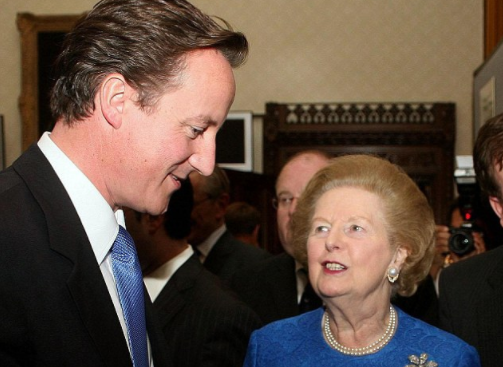



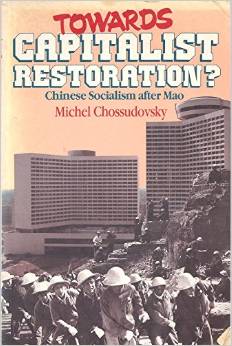

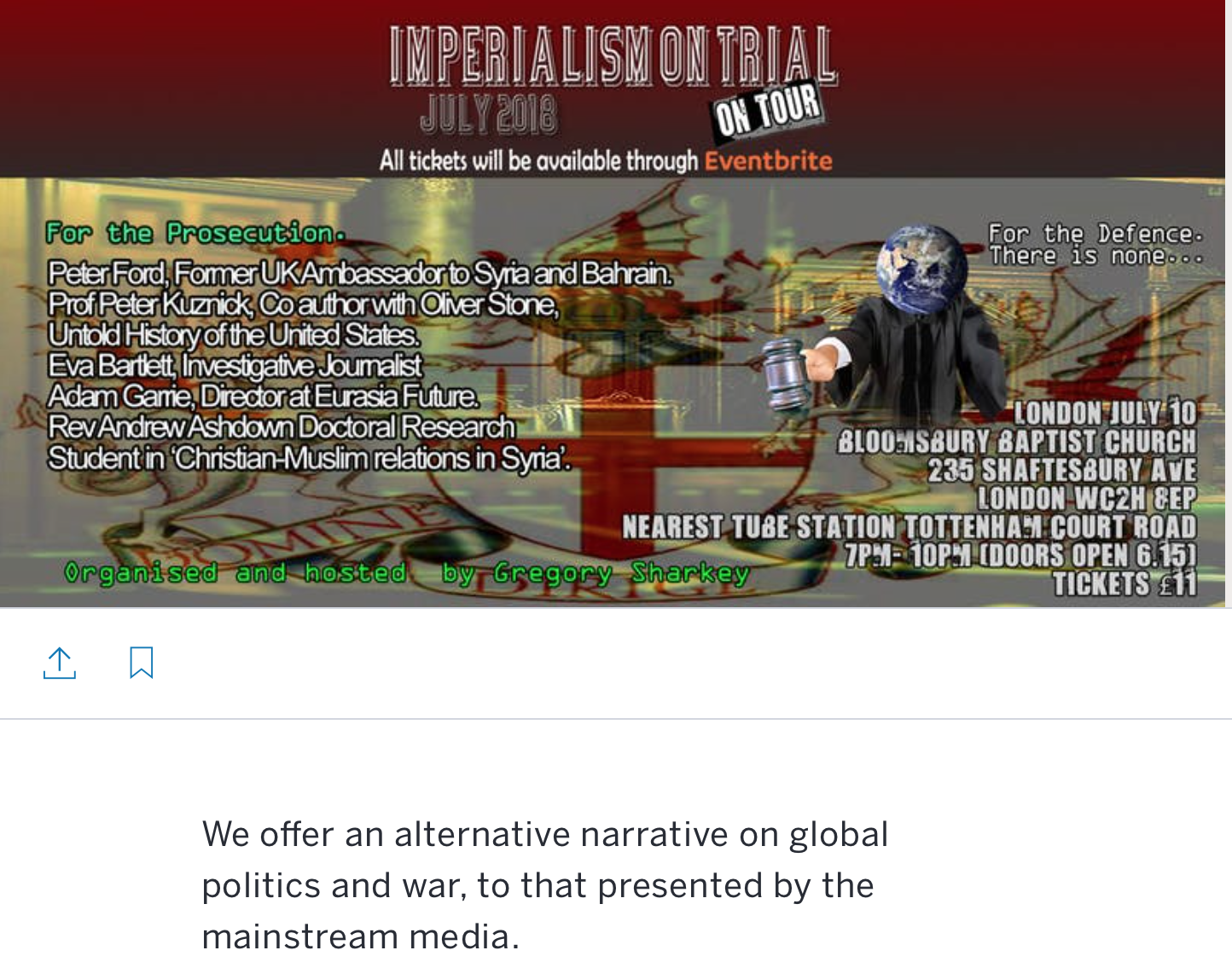



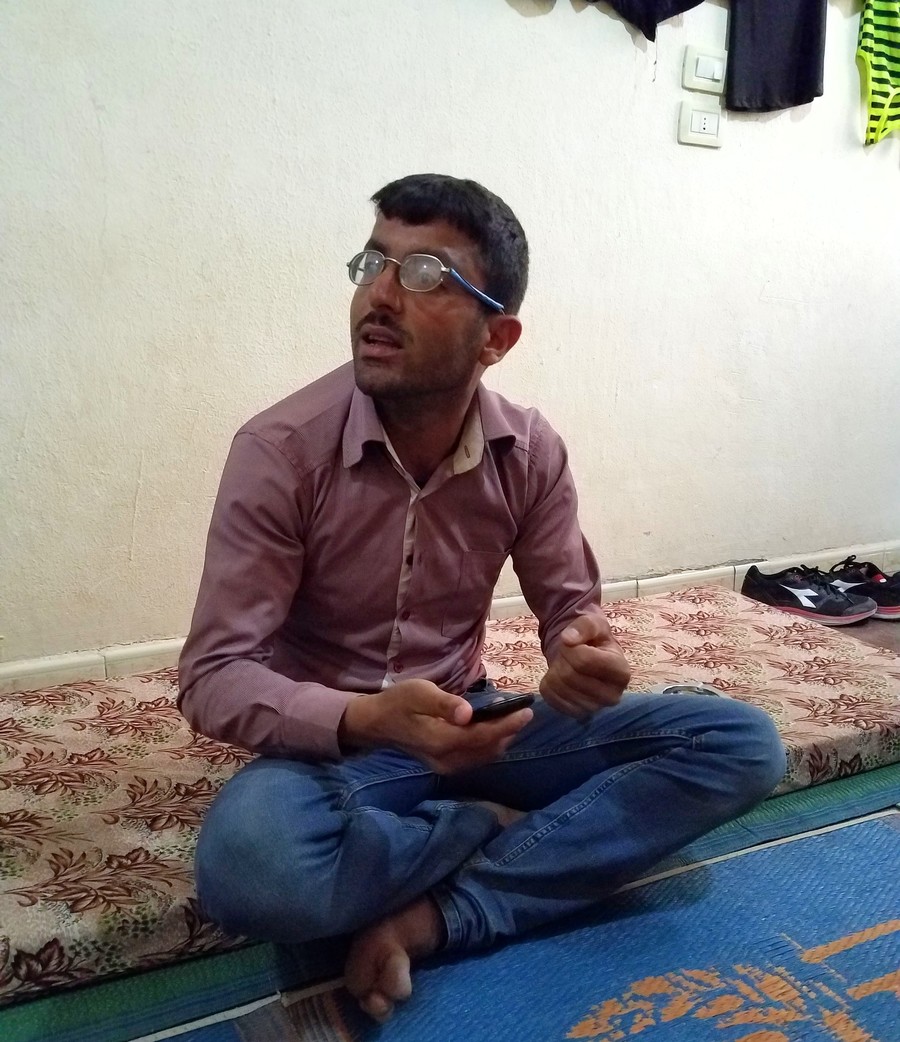

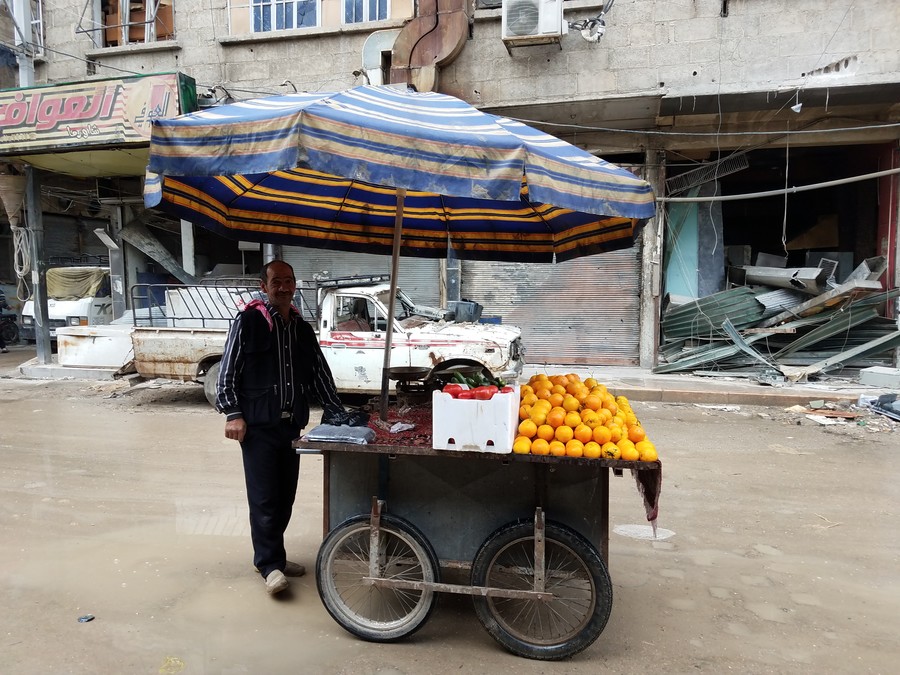
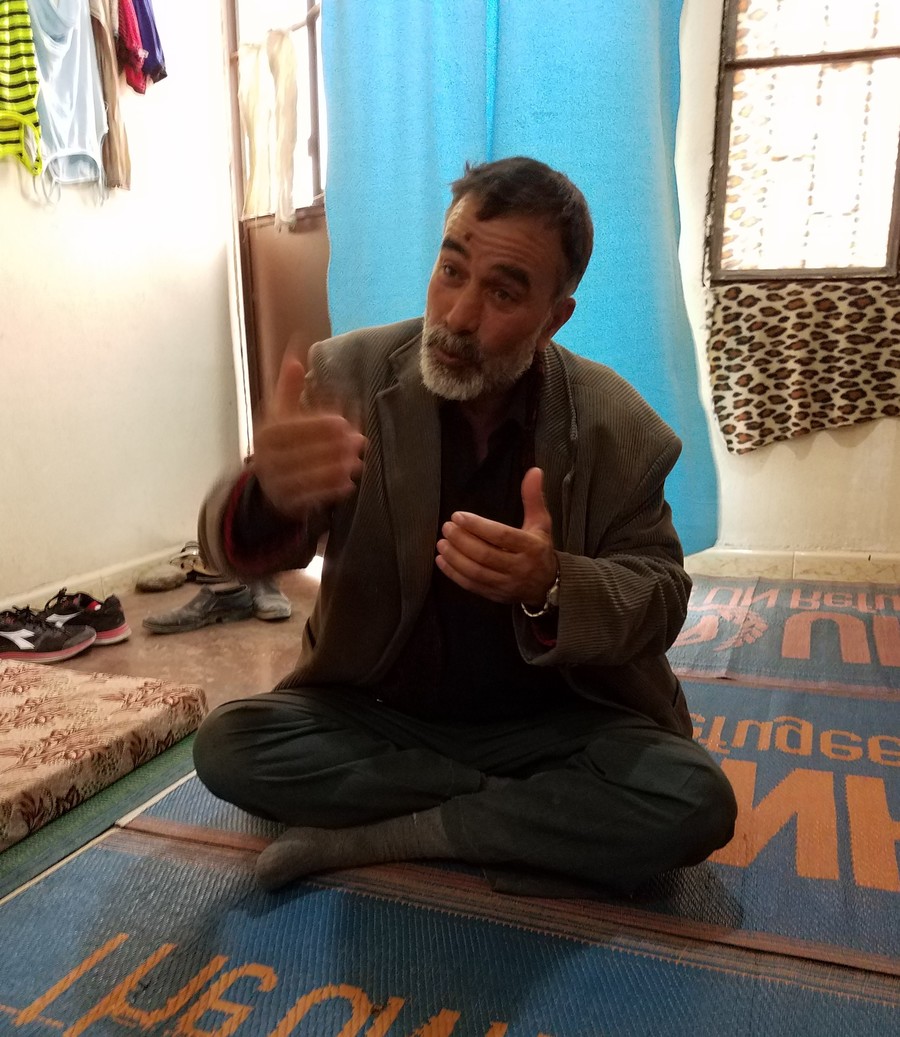

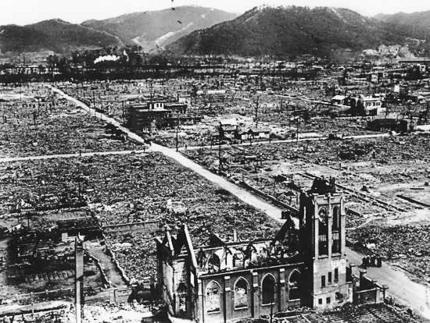
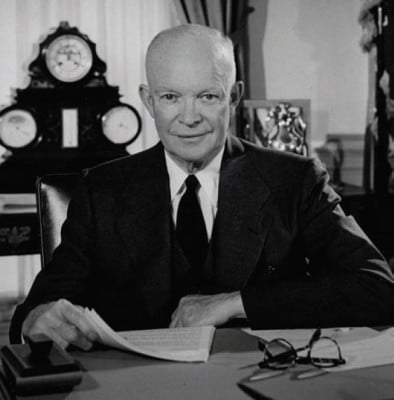
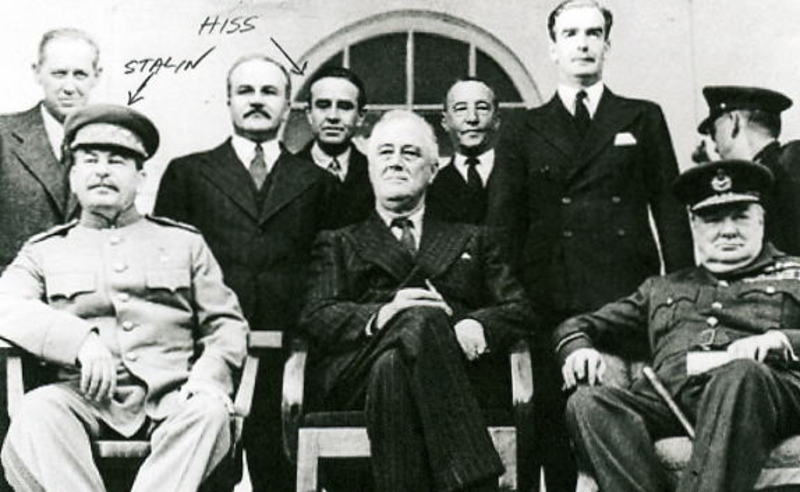
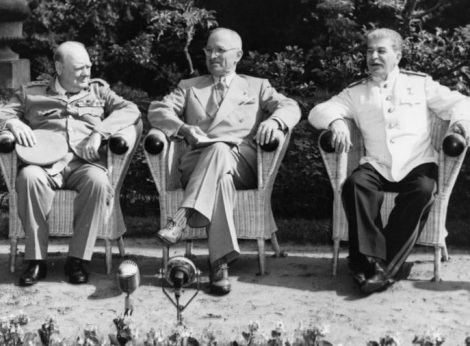
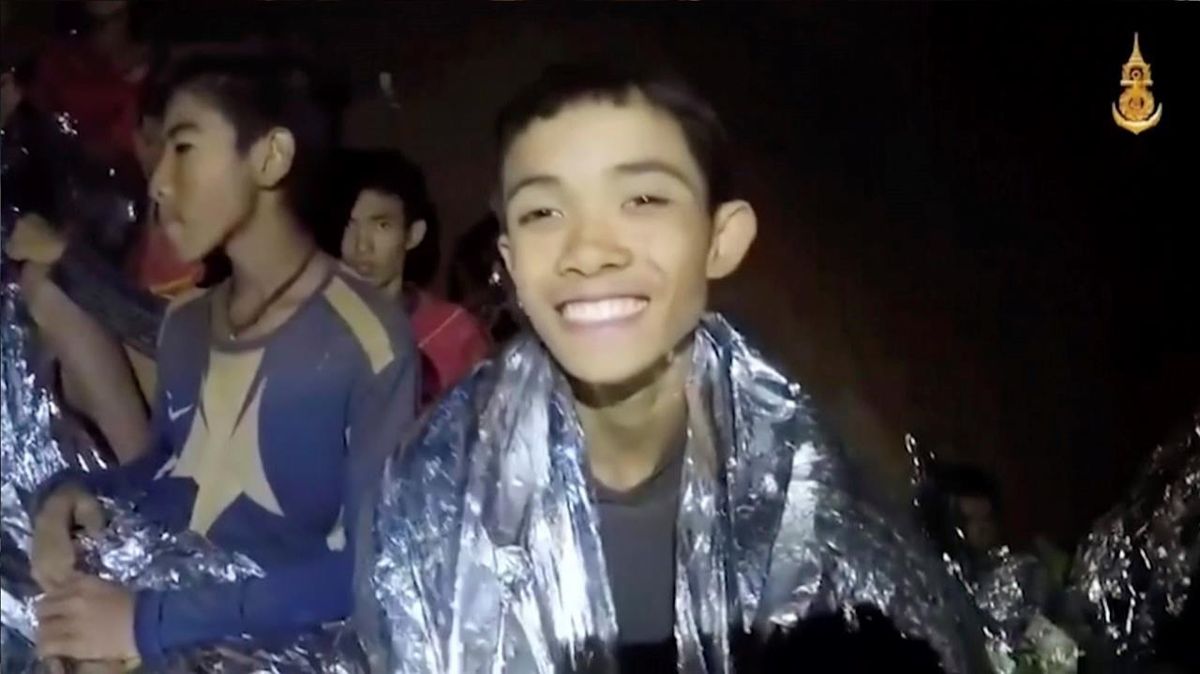
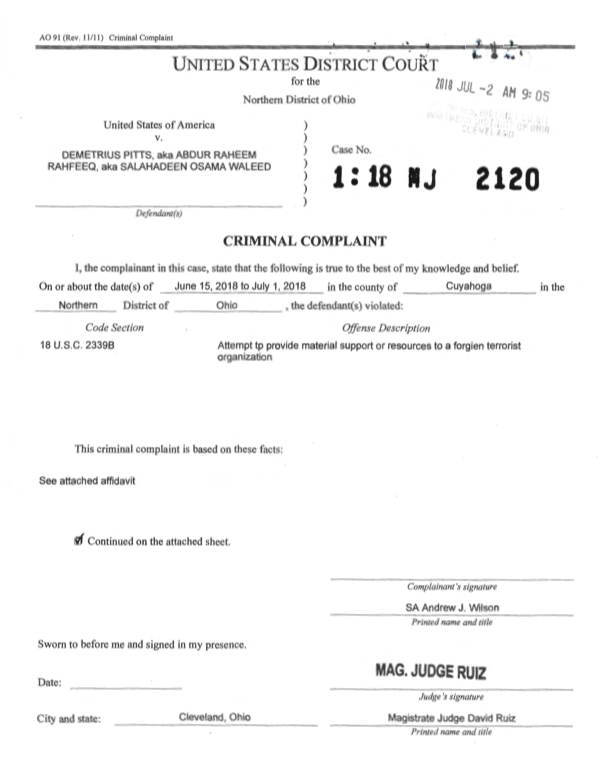

 Can you
Can you 